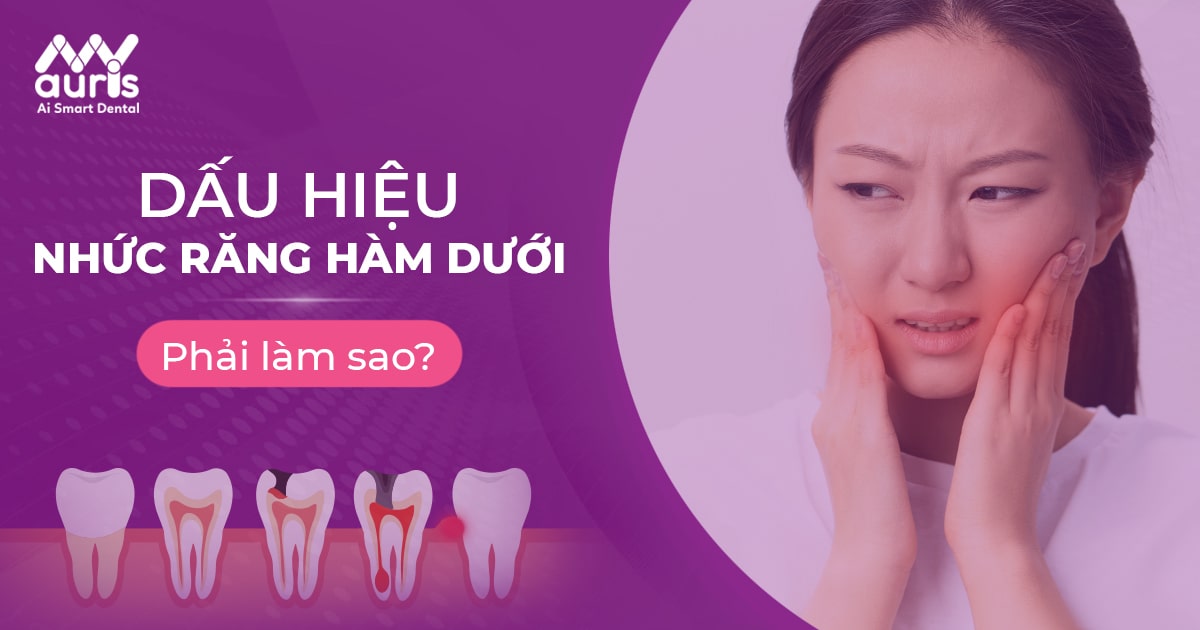Toothache is a sign that many people often encounter. However, for thorough treatment when there are signs of lower left tooth pain, it is most effective and safe. Join My Auris dentistry to share with you useful information about teeth..
Signs of tooth root infection when the lower left tooth hurts
It is due to pathogenic bacteria penetrating the tooth roots and quickly spreading through the surrounding oral areas. Or it can originate from pulpitis and pulp necrosis due to chipped teeth or cavities that are not treated promptly. Therefore, if you leave it for a long time, it will affect your health or even lose your teeth.

When there are signs of tooth root infection such as:
- Continuous toothache, causing throbbing, sharp pain, and can spread up or down the face.
- Teeth become more sensitive, especially when there is a change in temperature of food. Therefore, you need to limit foods that are neither too hot nor too cold. Besides, when you eat a lot of sugary foods and sweets, it can also cause irritation and toothache.
- Bleeding or swollen gums: When the diseased tooth is swollen, red and has pimples growing close to the tooth root or near the infected tooth. Causes you to have bad breath and discomfort due to the presence of pus.
- Tooth color changes: This is because the pulp has died. Therefore, the patient’s tooth root infection may change color to dark brown.
- Fever: headache, fever, nausea, etc. are signs of tooth root infection. If you have signs of a fever over 39 degrees Celsius, you need to go to a medical center for dental treatment.
Swollen gums
Swollen gums are one of the initial symptoms of gingivitis. The cause of gingivitis and swelling can be:
- Excess food left between teeth and tooth surface. If this plaque is left for a long time, it will irritate the gums, causing swelling and inflammation of the gums.
- Due to tooth decay, tooth decay bacteria spread, causing swelling and ulceration of the gums.
- Consuming food or drinks when it is too hot causes burns to the gums or too cold causes sensitive gums, causing swelling of the gums.
- Eating hot and spicy foods for a long time causes gum ulcers, swelling, and inflammation. pain.
Read more:How to treat swollen upper gums
Effective way to treat lower left toothache
1. Home treatment
- Maintain oral hygiene, brush your teeth at least twice a day before going to bed and after waking up.
- Use a toothbrush with soft bristles. Note that when cleaning your teeth, you should not brush the front teeth but should brush the xRotate circularly and vertically to avoid damage to gums and tooth enamel.
- Use dental floss to remove leftover food between teeth instead of toothpicks to limit the impact on the gums.
- Drink enough 1 – 2 liters of water a day
- Quit the habit of smoking, drinking alcohol, coffee, and soft drinks to protect oral health.
- Regularly clean teeth every 6 months to ensure oral health.

2. Dental treatment

For tooth root infections
To completely treat tooth infections safely and effectively requires a team of doctors to be highly qualified, meticulous and careful. Depending on the level of tooth infection of each patient. Steps to treat tooth root infections at a reputable dentist often include the following basic steps:
- General examination and X-rays to accurately assess the level of tooth infection as well as the complexity of the root canal.
- The doctor conducts treatment with anesthesia to remove the root canal.
- After that, the doctor conducts treatment with anesthesia to remove the tooth root.
- After that, the doctor The doctor will use tools to open access to the infected area, treat the infected area and remove the pulp.
- Place a temporary dental filling to prevent food from entering the root canal in cases of severe root canal infection.
- After the root canal has been completed, the doctor will fill the root canal to prevent bacteria from penetrating inside and cover the outside with a crown to help with the procedure. chew more as well as increase aesthetics.
For swollen gums
- Mild period of swollen gums
You should rinse your mouth with salt water or green tea to disinfect and reduce swelling. In addition, you should use a soft toothbrush and brush gently and properly to avoid making the inflammation worse.
If you are at a mild level of gum swelling, you should go to a dental facility to have your teeth scaled to clean your teeth to prevent the growth of bacteria.
If the swollen area still does not cause severe pain or bleeding. The doctor will prescribe some antibiotics to help fight swelling and inflammation.
- The stage of severe swelling of the gums at the base of the tooth
The doctor will clean the tartar under the gums as well as the pockets containing bacteria holding the gums and teeth.
In case of gingival swelling due to growth. tooth kkiss, the patient will be examined and advised to remove wisdom teeth if the swelling and inflammation are serious.
Use antibiotics and anti-inflammatory drugs as prescribed by the doctor.
In case the swelling of the gums has affected other soft tissues, the patient can directly have surgery to remove the damaged periodontal part and add a gum flap if necessary to avoid loose, loose or lost teeth. teeth.
Hopefully the above article, Mya Auris helps you better understand how to treat lower molar toothache effectively and safely. When you have a tooth infection, you need to quickly see a doctor to get advice on the most suitable treatment.
Jun Tran
You may be interested in:
? Common tooth tumor symptoms





